Planetary gear + strain wave gear precision from Schaeffler
- Details
- Hits: 3167
Precision gears have a significant influence on the dynamics, positioning and repeat accuracy or the service life of a construction. Schaeffler effect in the young company Ultra Precision Drives Two types of transmission have been developed that exceed the current state of the art: the Strain wave gear Series RT and the planetary gear of the PSC series. Learn how to use your Robotic-Take application to a new level.

Contents
- Gears for the metalworking industry
- Ultra Precision Drives takes off
- Dynamic market development - few manufacturers
- Wave gears for robots
- Who invented strain wave gears?
- What are the advantages of strain wave gears?
- Precision harmonic drive series RT1 and RT2
- Pushing boundaries with a new bearing design
- Angular needle bearing and precision gear unit for cobot joints
- Sensorized strain wave gears with high precision
- Wave gears for high and standard torque applications
- Torque sensors external versus internal
- Precision planetary gears from the PSC series
Gears for the metalworking industry
Sep 11.09.2023, XNUMX | Schaeffler would like to meet the challenges in the machine tool sector with more dynamics, precision, energy efficiency and longer machine running times. The company is presenting this at the EMO 2023 a new drive solutions.
Completely new drive concept for rotary tables
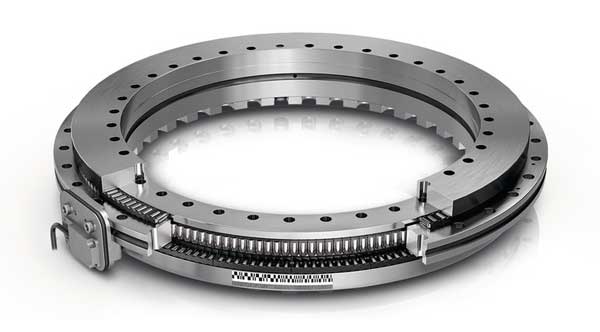 “In the machine tool industry, people in the machine tool industry understood the current factors as an opportunity remarkably quickly and responded to them. In this context, customers particularly often mention the reduction of electricity, air and cooling lubricant consumption and 'domestic sourcing', commented Ralf Moseberg, head of the Industrial Automation division at Schaeffler.
“In the machine tool industry, people in the machine tool industry understood the current factors as an opportunity remarkably quickly and responded to them. In this context, customers particularly often mention the reduction of electricity, air and cooling lubricant consumption and 'domestic sourcing', commented Ralf Moseberg, head of the Industrial Automation division at Schaeffler.
"The aim of investments is to optimize running times and utilization and to be able to use production systems more flexibly with the help of new automation solutions. This is where the main focus is Robot and cobots with particular consideration of ROI as well as the development and application of new technologies such as Direct drive technology a central role.”
A highlight at the trade fair will be a Swivel rotary table with a directly driven turntable via the SRV and RKIB motors. The exhibit presents two solutions that can be clearly compared and discussed.
A direct drive is used to drive the rotary table Axial-radial bearings The YRTCMA series with an integrated, inductive absolute angle measuring system is used. On the other hand, the completely newly designed drive for swivel axes is equipped with a precision planetary gear PSC implemented with servo motor. The constant torsional backlash of just 0,1 arcmin over the service life makes it possible for the first time to dispense with a second drive for tensioning and eliminating torsional backlash.
Gearboxes for light machining tasks
 Aug 31.08.2023, 2023 | At EMO 1, Schaeffler is presenting its RTXNUMX precision wave gearboxes, which can also be optionally integrated and space-neutral torque sensors are available as RT1-T. Also on display will be the PSC precision planetary gearboxes with automatic torsional backlash compensation.
Aug 31.08.2023, 2023 | At EMO 1, Schaeffler is presenting its RTXNUMX precision wave gearboxes, which can also be optionally integrated and space-neutral torque sensors are available as RT1-T. Also on display will be the PSC precision planetary gearboxes with automatic torsional backlash compensation.
With these precision gears, numerous automation solutions can be implemented in a very wide range of applications, as in Machine Tools, welding positioners, rotary indexing tables, tube bending machines, Cobots and many other applications. Both types of gears will be presented at the trade fair in milling heads for light machining tasks.
The Precision shaft gear RT are now also offered as individually configurable precision drives with motor, feedback system and optionally integrated controller. In this way, users can concentrate on their core competencies when developing the machine without having to do without tailor-made precision drives.
Ultra Precision Drives takes off
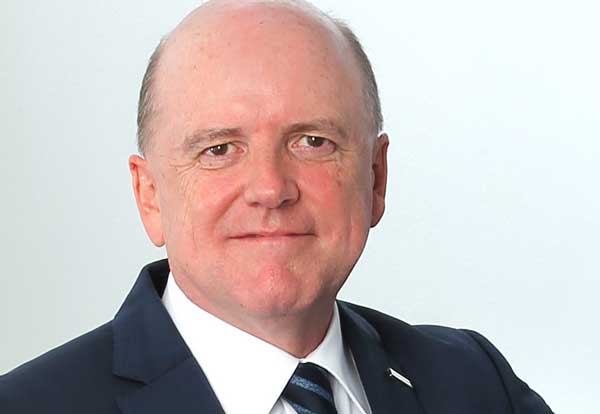 21.03.2023/XNUMX/XNUMX | Because gears are used in most precision drives for industries such as B. robots, machine tools, industrial automation or Medical Technology represent a key component, Schaeffler has its development competencies, production technologies, products and services in the area of precision gears under one roof Ultra Precision Drives summarized.
21.03.2023/XNUMX/XNUMX | Because gears are used in most precision drives for industries such as B. robots, machine tools, industrial automation or Medical Technology represent a key component, Schaeffler has its development competencies, production technologies, products and services in the area of precision gears under one roof Ultra Precision Drives summarized.
Products with this label not only exceed the current state of the art, but sometimes even set the benchmark in the market - and that after a relatively short time since Schaeffler opened this area within the company. Two gear types and three series cover nominal torques of 10 to over 5 Nm .
This means that the industry has access to precise epicyclic gearboxes for secondary and main axes in machine tools, for positioning drives in automation or as robot gearboxes for small to large cobots industrial robots to select.
Dynamic market development - few manufacturers
Ralf Moseberg, Senior Vice President Industrial Automation at Schaeffler, commented on the trends in the robotics market at a press conference in the run-up to Automatica: He sees a high degree of flexibility and dynamics, which is accompanied by a smooth transition between collaborative robots or cobots and Industrial robotsn. The manufacturers rely on simple ones here Coding and Machine learning.
Nicolai Hammerle, Vice President Business Field Robotics at Schaeffler, sees a big movement in logistics. And mobile automated robotics is also on the rise. In medical technology, possibilities are opening up to separate the operating doctor from the patient. The question is whether you would want it that way yourself, but this trend can no longer be stopped. At Kia Hyundai there is already a final acceptance of one Automobiles, which only robots perform without human intervention, as this film shows:
Potential far greater than current sales rate figures
There is a broad consensus in the industry that sales figures for collaborative robots many times higher could be if some technical challenges were solved. Manufacturing corporations as medium-sized companies want higher speeds and accelerations for higher productivity in the self-sufficient use of cobots. The necessary sensitivity in the collaborative mode with attractive costs is also missing.
 Planetary gearboxes for numerous applications
Planetary gearboxes for numerous applications
Cobots can be used very flexibly if they combine both properties. They work collaboratively during the day and autonomously at night like the classic industrial robot. In this way, companies achieve the ROI much faster with significantly increased productivity. In this scenario, demand would quickly increase sharply. And so the international press is already wondering whether the few medium-sized suppliers of cobot components could even meet the growing demand.*1
Wave gears for robots
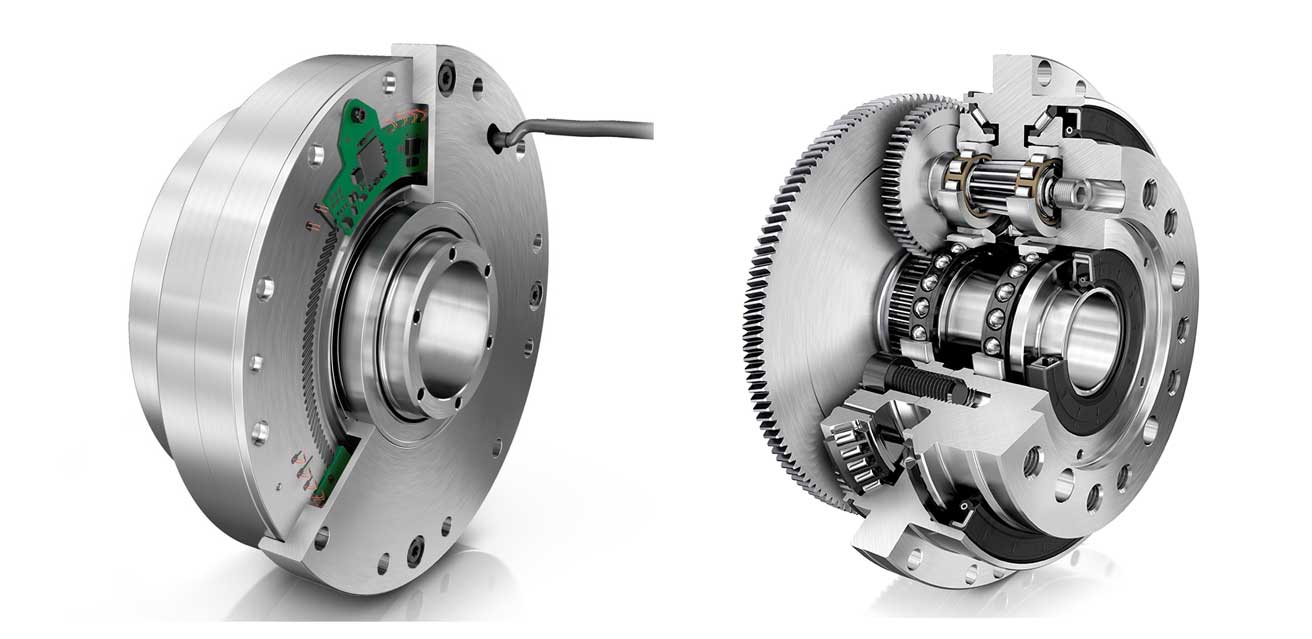
20.04.2023/XNUMX/XNUMX | Against this background, the automotive and industrial supplier has significantly expanded its gear portfolio and production capacities for robot axes in lightweight robotics and developed two gear series with high precision: the backlash-free precision strain wave gears RT1 and RT2 as well as the precision planetary gears of the series PSC.
The RT strain wave gears cover a torque range from 10 to a maximum of 484 Nm, the PSC gears in the smallest size 030 start at 327 Nm. Robot manufacturers thus have the option of being able to select the most suitable gearbox design and size for their robot axes. But what actually is a harmonic drive and where does it come from?
Who invented strain wave gears?
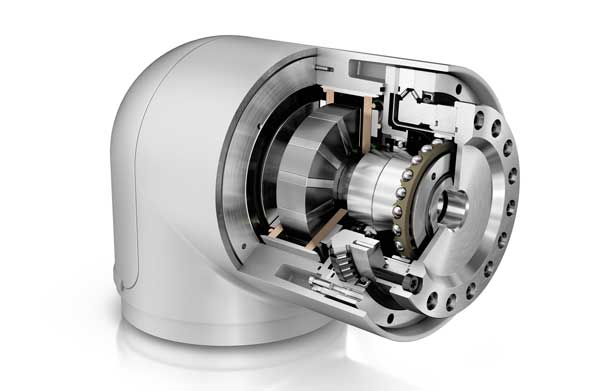 In the group of GearThe wave gears stand out particularly due to their elastic element, the so-called flexspline. This was ensured by the installation in the wheel drives at the beginning of the 1970s Lunar Roving Vehicles, which were used during the Apollo missions. After the successful use of robot gears, they found their way into other areas of application such as in aviation and medical technology or for tracking parabolic antennas and solar panels.
In the group of GearThe wave gears stand out particularly due to their elastic element, the so-called flexspline. This was ensured by the installation in the wheel drives at the beginning of the 1970s Lunar Roving Vehicles, which were used during the Apollo missions. After the successful use of robot gears, they found their way into other areas of application such as in aviation and medical technology or for tracking parabolic antennas and solar panels.
The three examples of the Lunar Roving Vehicles were left on the moon. The strain wave gears invented by Walton Musser in the 1950s were installed in the four electric wheel drives*2.
In industrial automation strain wave gears have been used as precision servo gears for decades. As the first strain wave gears in series production, stress wave gears came onto the market as Harmonic Drive gears under the brand name Harmonic Drive. Today strain wave gears are the preferred type of gear for small articulated arm robots with payloads of up to 20 kg.
What are the advantages of strain wave gears?
- Very high transmission ratio in one stage
- Freedom from play generated from the pre-tensioning of the toothing of the Flexspline and Circular-Spline
- High positioning and repeat accuracy
- Option of a hollow shaft for the Cablesexecution
- Very compact design and low mass
Inventor's Expansion Wave Gear Patents Walton Musser from 1955 have long expired. Therefore, the manageable number of manufacturers in the present is all the more surprising. But this is probably also due to the many niche applications and sophisticated gearing technology.
Precision harmonic drive series RT1 and RT2
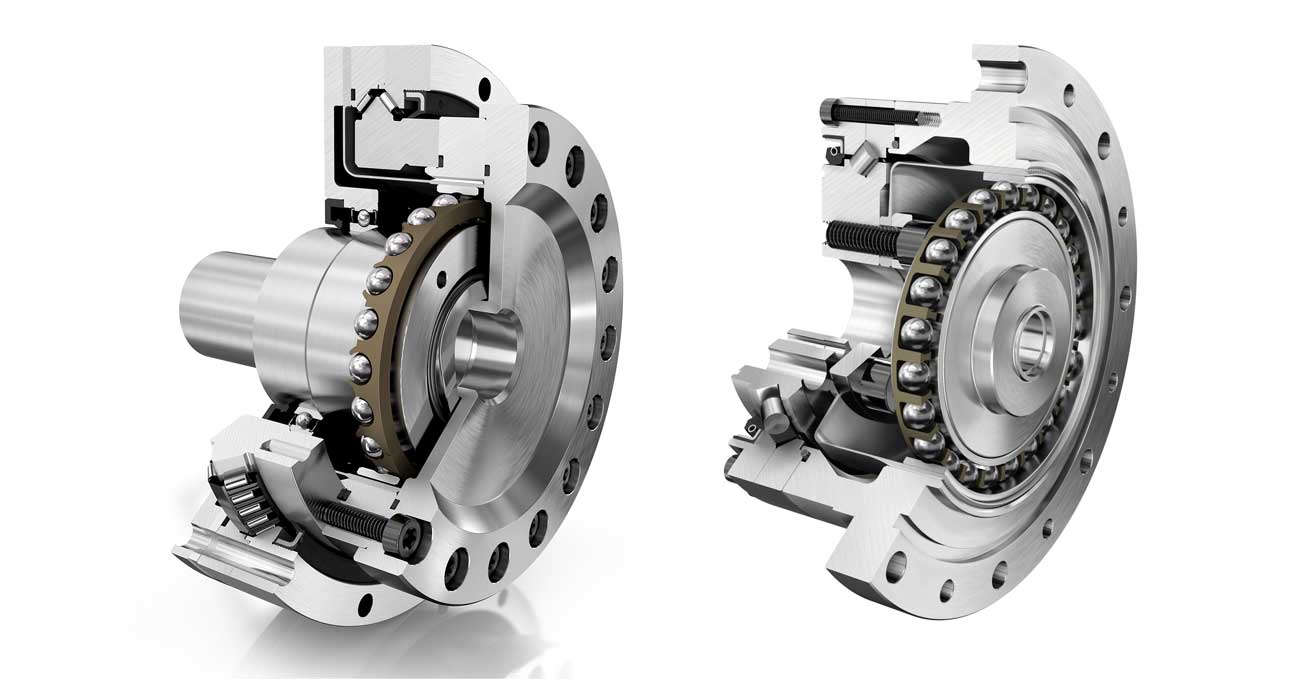
Both series RT1 and RT2 have comparable sizes. Precision harmonic drives of the High Torque RT1 series exceed the Standard Torque RT2 series by an average of 30% in terms of torque and 40% in terms of service life. Precision harmonic drives of the Standard Torque RT2 series are characterized by an extensive portfolio of sizes, variants and gear ratios. Precision harmonic drives of the High Torque RT1 series are equipped with an integrated torque sensors available as RT1-T, which, as a special feature, does not introduce any additional elasticity into the robot's drive train.
The RT precision shaft drives for robots can optionally be combined with suitably matched motors and an optionally integrated torque sensor (RT1-T) to form compact drive units Encoder and Brake be completed. A particularly rigid bearing on the output is achieved by using angular needle bearings from the XZU series.
Pushing boundaries with a new bearing design
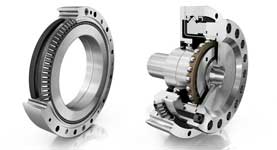 14.04.2023/XNUMX/XNUMX | The bearing technology in articulated arms from lightweightboutside usually uses crossed roller bearings. However, the design of such bearings has already reached its limits in terms of its tilting rigidity. Schaeffler has considered using the needle roller as a promising alternative and the double row Angular needle bearing XZU
14.04.2023/XNUMX/XNUMX | The bearing technology in articulated arms from lightweightboutside usually uses crossed roller bearings. However, the design of such bearings has already reached its limits in terms of its tilting rigidity. Schaeffler has considered using the needle roller as a promising alternative and the double row Angular needle bearing XZU
Angular needle bearing and precision gear unit for cobot joints
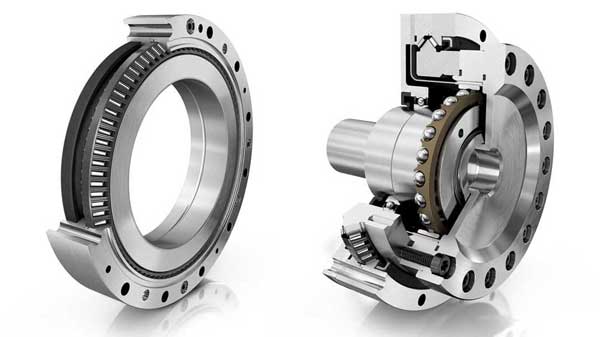 14.04.2023/2020/XNUMX | Lightweight robots (LBRs) and collaborative robots (cobots) have to work highly dynamically and precisely in modern production. With the development of the angular needle bearing, XNUMX also became the new Precision gear unit RTWH developed. This has opened up new opportunities in the rapidly growing market segment. The new roller bearing XZU is used as the main bearing for the precision gear. The combination of Transmission and XZU offers maximum compactness and rigidity in the application.
14.04.2023/2020/XNUMX | Lightweight robots (LBRs) and collaborative robots (cobots) have to work highly dynamically and precisely in modern production. With the development of the angular needle bearing, XNUMX also became the new Precision gear unit RTWH developed. This has opened up new opportunities in the rapidly growing market segment. The new roller bearing XZU is used as the main bearing for the precision gear. The combination of Transmission and XZU offers maximum compactness and rigidity in the application.
Due to the better performance, the user can choose a smaller roller bearing size, thus saving installation space and weight. This is an essential aspect with regard to the topic of downsizing. Overall, there are new possibilities in the development of these robots.
For Cobot joints designed, Schaeffler also refers to the RT1 and RT2 series as ready-to-install reduction gears in the Silk Hat design as "speed reducers". The operating principle of harmonic drive enables high torque capacity, high reduction ratios with a relatively light design. The precision gear is backlash-free, positioning accurate, compact and has a long service life.
Especially the high one Lifespan the gearbox is of great importance for robots because they have to work reliably and with as little downtime as possible. Depending on the size, the manufacturer offers reductions from 50 to 150. The resulting torques are transmitted precisely and safely through the combination of the gearbox with the rigid angular needle bearing and the robust design. In this way, the robot can be moved dynamically, precisely and without high post-oscillation effects to the end position, where it can work very efficiently. Sorting, assembling and handling work of the robot can be done accurately in a short time. The precision gear has a maintenance free Design and is available in standard sizes. The drive flange is designed as a hollow shaft and can be designed individually.
Sensorized strain wave gears with high precision
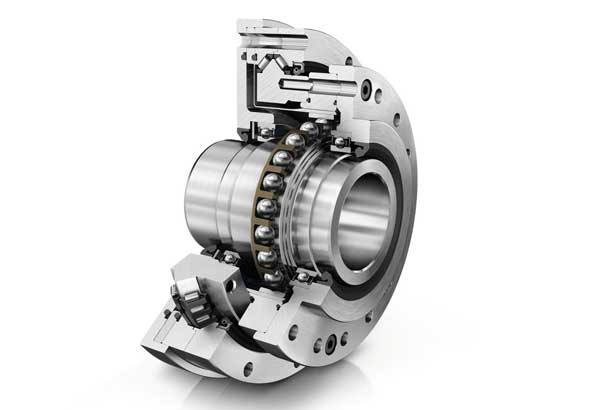 11.05.2022/XNUMX/XNUMX | The manufacturing industry needs Lightweight roboticsthat act with high dynamics and precision. At the same time, applications in the Food industry and medical technology have a high level of sensitivity, while flexibility and user-friendliness are paramount in medium-sized companies.
11.05.2022/XNUMX/XNUMX | The manufacturing industry needs Lightweight roboticsthat act with high dynamics and precision. At the same time, applications in the Food industry and medical technology have a high level of sensitivity, while flexibility and user-friendliness are paramount in medium-sized companies.
“These demanding goals cannot be achieved with just one component. We have fundamentally tackled this challenge and have new ones for lightweight robots and cobots main camp, Engines, transmission and a fully integrated sensors developed," says Ralf Moseberg, Head of the Industrial Automation business unit at Schaeffler.
"With our solution package, cobots can, for example, simultaneously move around 50 percent faster be able to transport 30 percent heavier loads and for sensitivity we offer an innovative concept with our sensorized wave gears. This will open up further fields of application.”
The RT precision harmonic drive were designed for particularly dynamic and demanding applications with a high torque level. Wave gears with fully integrated torque sensors are available as an option. Without additional installation space and loss of rigidity of the entire mechanics, it has the task of delivering highly accurate torque signals. To date, the market has lacked a long-lasting sensor solution that is suitable for series production. This gap is closed with the sensorized wave gear RT.
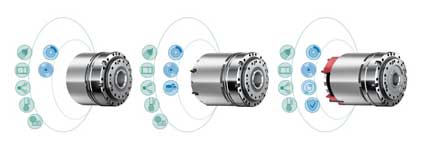 Robot drives for the rapidly growing market
Robot drives for the rapidly growing market
In contrast to other corrugated gears on the market, the strain gauge structure on the Flexspline in the sensorized precision corrugated gears was in thin film technology permanently applied. The torque sensor supports safety functions and sensitive, precise position and process control. The torque signals can also be used to develop active vibration compensation. This means that shorter settling and positioning times can be achieved with highly dynamic movements.
Wave gears for high and standard torque applications
The two precision harmonic drive series for lightweight robots and cobots include the RT1 for the high-torque area and that RT2 for the standard torque application. RT2 gears cover around 80% of the usual cobot applications. The series includes five sizes from 14 to 32 and five ratios from 50 to 160. There are variants with Hollow shaft and for direct attachment to the robot's motor shaft, as a closed unit with seals and as a component set. The RT1 gearboxes are available in four sizes from 14 to 32 with ratios of 100 and 160 for torques from 25 to almost 900 Nm. Thanks to the high torque density, the RT1 wave gears can be used to create particularly compact articulated arms for above-average loads.
Torque sensors external versus internal
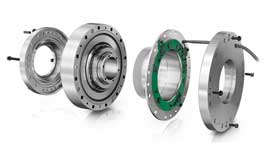 02.06.2023/XNUMX/XNUMX | Should Cobots to work sensitively and force-controlled and to teach smoothly, you need one sensorsto get measurement data from the external forces. Schaeffler has for this Torque sensors developed for cobots that are integrated into precision strain wave gears.
02.06.2023/XNUMX/XNUMX | Should Cobots to work sensitively and force-controlled and to teach smoothly, you need one sensorsto get measurement data from the external forces. Schaeffler has for this Torque sensors developed for cobots that are integrated into precision strain wave gears.
Precision planetary gears from the PSC series
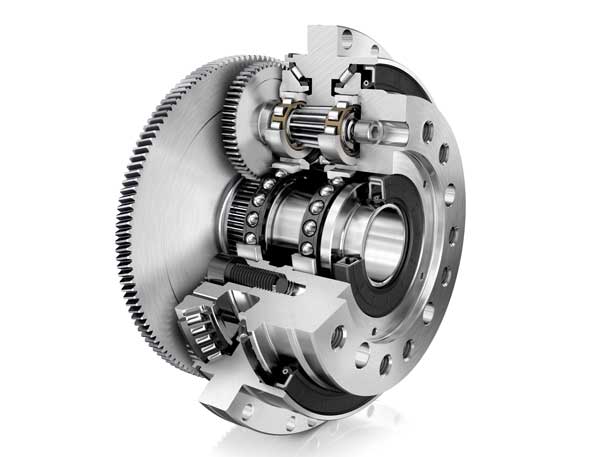 29.04.2023 | PSC is the name of the three-stage planetary gear with helical drive stage and integrated main bearing. Compared to other technologies are the gears
29.04.2023 | PSC is the name of the three-stage planetary gear with helical drive stage and integrated main bearing. Compared to other technologies are the gears
- P = most precise
- S = the quietest and the whole at
- C = constant lifetime
With the precision planetary gears of the PSC series for industrial robots, designers have a to Factor ten less torsional backlash and a service life extended by a factor of three.
Wear compensation keeps the extremely small torsional backlash of the gear constant. Such large leaps in development are very rare and an opportunity for industrial robotics to overcome previous limits.
The PSC precision gearboxes are suitable for a particularly wide range of industrial applications. This is ensured, among other things, by a large variety of variants. This results from eight sizes with solid shaft and hollow shaft, installation kits and complete gear blocks as well as different motor mounting variants. The connection between the spur gear stage and the planetary stage has the function of allowing wide adjustment to the desired speed and torque range.
What advantages do planetary gears offer?
- minimum torsional backlash (0,1 arcmin)
- maximum torsional and tilting rigidity
- particularly long service life of 20.000 operating hours
With these features, the precise planetary gears are ideally suited for all industrial precision drives. Due to the patented toothing technology of the planet gears and helical gear stage at the entrance there is a low noise level of only 65 dB(A). The robot gearbox offers high efficiencies of over 90% at full load. This results in stable temperature behavior and low energy consumption.
Patented gearing technology
The outstanding feature of the PSC planetary gearbox is the patented gearing technology. It reduces the torsional backlash of the epicyclic gear 0,1 arcmin and keeps the service life constant at 20.000 operating hours thanks to an adjustment mechanism.
The PSC series includes nine sizes of planetary gears from 030 to 500 with planetary stage ratios between 9 and 20, input stage ratios from 3,4 to 15,7 and outside diameters from 155 to 405 mm. The torsional rigidity is particularly high and is achieved, among other things, with the four or five planetary gears mounted on both sides.
PSC planetary gearboxes are available as installation kits and as closed units with and without angle preamp. These varied rotary gearboxes can be easily integrated into the customer's design. They are already being used very successfully in industrial robots with load capacities of up to around 100 kg.
Schaeffler is exhibiting at the Automatica 2023.
Sources:
1. https://asianroboticsreview.com/home214-html
2. National Aeronautics and Space Administration

Angela Struck is editor-in-chief of the development scout and freelance journalist as well as managing director of Presse Service Büro GbR in Ried.
